

The Perils of Restoring "Less Is More" By Sara Hart Ronald Krueck, FAIA, and Sexton, both alumni of IIT, were well aware that the starkness of Mies’s work does not equate to simplicity, nor was his bias in favor of off-the-shelf components suggest a generic architectural vocabulary.
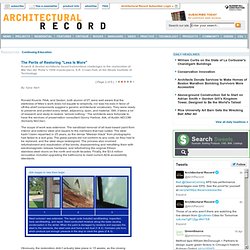
They were ready to preserve and protect every detail, adjacency, span, and material. Still, it takes a lot of research and study to restore “almost nothing.” The architects were fortunate to have the services of preservation consultant Gunny Harboe, AIA, of Austin AECOM (formerly McClier). The scope of work was extensive: The sandblast removal of all lead-based paint from interior and exterior steel and repairs to the members that had rusted.
Obviously, the restoration didn’t actually take place in 15 weeks, as the closing ceremony pronouncements suggested. The first task was to quickly shroud the entire building in order to contain dust from the lead-based paint that was to be sandblasted off all the steel members. Crown Hall Restoration - Krueck+Sexton Architects. Crown Hall Restoration Chicago, IL | 2005 S.
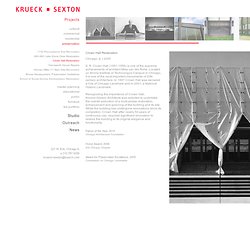
R. Crown Hall (1951-1956) is one of the supreme achievements of architect Mies van der Rohe. Located on Illinois Institute of Technology's Campus in Chicago, it is one of the most important monuments of 20th century architecture. Recognizing the importance of Crown Hall, Krueck+Sexton Architects was selected to undertake the overall execution of a multi-phase restoration, enhancement and greening of the building and its site.
Patron of the Year, 2010 Chicago Architecture Foundation Honor Award, 2006 AIA Chicago Chapter Award for Preservation Excellence, 2005 Commission on Chicago Landmarks. Mies van der Rohe Society. University of East Anglia research identifies second housing crisis - and a solution to both. Modern building standards are set to leave a legacy of high bills and potential poor health according to a new report from the University of East Anglia.
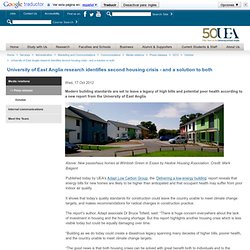
Above: New passivhaus homes at Wimbish Green in Essex by Hastoe Housing Association. Credit: Mark Baigent Published today by UEA’s Adapt Low Carbon Group, the ‘Delivering a low-energy building’ report reveals that energy bills for new homes are likely to be higher than anticipated and that occupant health may suffer from poor indoor air quality. It shows that today’s quality standards for construction could leave the country unable to meet climate change targets, and makes recommendations for radical changes in construction practice. The report’s author, Adapt associate Dr Bruce Tofield, said: “There is huge concern everywhere about the lack of investment in housing and the housing shortage. But this report highlights another housing crisis which is less visible today but could be equally damaging over time. University of East Anglia research identifies second housing crisis - and a solution to both.
‘Delivering a low-energy building’ report calls for widespread adoption of Passivhaus. Microsoft Word - Delivering a low-energy building October 2012 - delivering_a_low-energy_building_oct_2012.pdf. ‘Delivering a low-energy building’ report calls for widespread adoption of Passivhaus. Another One Bites The Dust: Walter Gropius Buildings Being Torn Down in Chicago.
Photograph: © Grahm M.
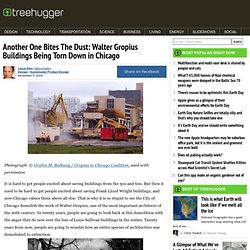
Balkany / Gropius in Chicago Coalition, used with permission It is hard to get people excited about saving buildings from the 50s and 60s. But then it used to be hard to get people excited about saving Frank Lloyd Wright buildings, and now Chicago values them above all else. That is why it is so stupid to see the City of Chicago demolish the work of Walter Gropius, one of the most important architects of the 20th century. In twenty years, people are going to look back at this demolition with the anger they do now over the loss of Louis Sullivan buildings in the sixties. One can talk about the green, sustainable side, how "the greenest building is the one already standing" as Carl Elefante says, or how "the greenest brick is the one already in the wall" as Steve Mouzon puts it. Wikipedia But for once, let's look at the idea of embodied genius.
Lots more at the Gropius in Chicago Coalition. Post World War Architecture by Shivani Shah on Prezi. Ludwig Mies van der Rohe. Ludwig Mies van der Rohe (born Maria Ludwig Michael Mies; March 27, 1886 – August 17, 1969) was a German-American architect.[1] He is commonly referred to and was addressed as Mies, his surname.
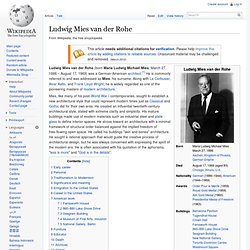
Along with Le Corbusier, Alvar Aalto, and Frank Lloyd Wright, he is widely regarded as one of the pioneering masters of modern architecture. Mies, like many of his post-World War I contemporaries, sought to establish a new architectural style that could represent modern times just as Classical and Gothic did for their own eras. He created an influential twentieth-century architectural style, stated with extreme clarity and simplicity.
His mature buildings made use of modern materials such as industrial steel and plate glass to define interior spaces. He strove toward an architecture with a minimal framework of structural order balanced against the implied freedom of free-flowing open space. Early career[edit] Mies was born in Aachen, Germany. Personal[edit] Traditionalism to Modernism[edit]